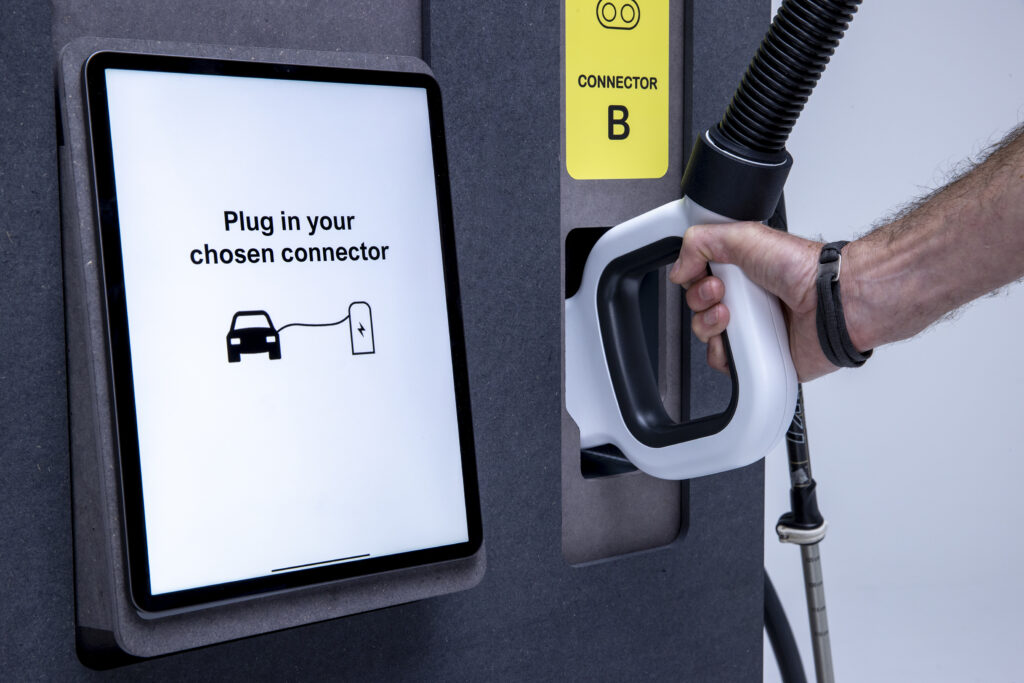Mobility aids
What are they, and why do they matter for public EV charging?
People who use mobility aids
Many people associate disability with wheelchairs, but only a small proportion of disabled people are wheelchair users.
Bear in mind that an individual may use more than one type of walking aid, for example to cover longer or shorter distances, or because their needs change throughout a day or on different days.
Someone who uses a mobility aid may not use it all the time. For example, some people are full-time wheelchair users and others are “ambulatory” (can walk) some of the time.
Here we provide some basic information about using different mobility aids in the context of public EV charging.
For more details about mobility aids in general, try an Independent Living Centre, for example Devon County Council’s guides to mobility equipment (opens in a new window).




Walking aids
Some people use one or two walking sticks, which may be the traditional curved wooden kind or more modern metal or carbon fibre designs, or even walking poles. Others use one or two crutches, which can have a range of designs including taking weight under the arms, on the hands or on the forearms.
For public EV charging, using these can mean:
- The person may have limited balance
- One or more hands may be unavailable, when holding a stick or crutch
- The need for somewhere to prop one or two sticks or crutches
- The need for a wide space to walk, as crutches or sticks can stick out beside a person
- Difficulty walking on uneven or slippery surfaces
- Reduced reach, if a person is leaning on forearm crutches
Some people use walking frames or similar wheeled walkers, which can mean:
- The need for wide spaces to move around outside a vehicle and between street furniture
- The person may need to hold onto or lean on the frame or walker when standing still
- Reduced forward reach, as the frame is positioned between the person and the object in front of them
Wheelchairs
Manual wheelchairs are ones that can be pushed by a person. These are either “self-propelled” (where the wheelchair user pushes the chair usually using “push rims” around the wheels) or “attendant propelled” where another person pushes the wheelchair.
Powered wheelchairs are battery-powered, and usually driven by a person moving a joystick on the armrest.
Key considerations for public EV charging by wheelchair users:
- Wheelchair users will be at seated height when they see, reach and use any parts of a charging unit, as well as needing to see and read signage easily from their chairs, unless they are able to stand to use the charging unit
- Some wheelchair users are not able to move up or down even very low kerbs, so fully-flush dropped kerbs, ramps or level surfaces are needed to enable access
- Some wheelchairs are lightweight, and need to be assembled safely next to the side or rear of a vehicle by the wheelchair user or by someone else
- Some wheelchair users transfer out of their wheelchair at the side of their vehicles (e.g. sit in the driver’s seat to drive, then move across into their wheelchair). This can require the parking space and the space next to the vehicle to be on the same level, so that they can easily transfer across without needing to move onto a much higher or lower seat level
Mobility scooters
Mobility scooters can range from large heavy ones with the biggest turning circles to small, lightweight foldable ones.
For public EV charging, people using mobility scooters may:
- Need plenty of space to move and turn around near the vehicle and at a charging unit
- Have large parts of the scooter in front of them, which can restrict their forward reach
- Need to see, reach and use parts of a charging unit from seated height, if they cannot stand
- Need space next to or behind a vehicle to unfold a scooter, or to move it in and out of the vehicle
- Need space to use ramps or lifts to move a scooter, sometimes being driven, in and out of the vehicle

Design guidance
Take a look at our suggestions for making public EV charging more accessible



